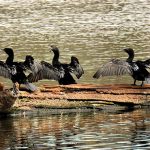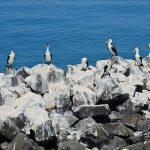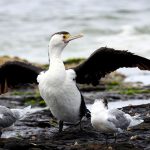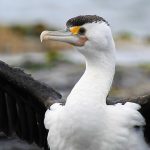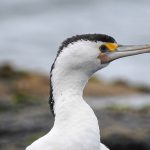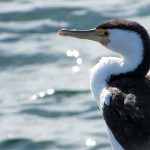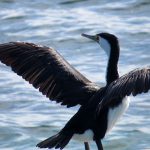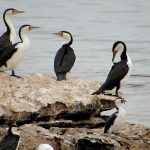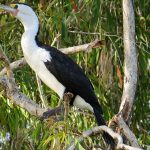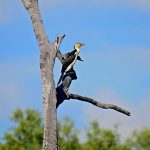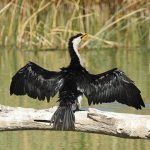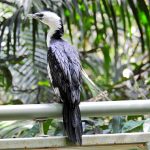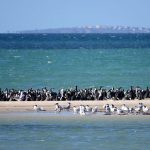PIED CORMORANT
The Pied Cormorant, also known as the Pied Shag, is a striking bird species commonly found in coastal and inland waterways across Australia and New Zealand.
The Pied Cormorant graces a wide range of aquatic habitats. Its preferred locales include estuaries, large rivers, lakes, and coastal bays. In Australia, these birds can be found from the northern regions of Western Australia, across the top end, down through Queensland, New South Wales, Victoria, and South Australia, even reaching the waters of Tasmania. They are versatile inhabitants, adapting to both salt and fresh water environments.
Visually, the Pied Cormorant is quite distinctive. It has a black and white plumage that gives it a dapper appearance. Its upper parts are mostly black with a sheen that can appear bluish or greenish in the sunlight, while its underparts are primarily white. This bird has a long, slender neck and a slightly hooked bill, which is grey-yellow in colour. It has green eyes with a blue eye ring, which adds a splash of colour to its monochrome attire.
Pied Cormorants are skilled hunters. They dive underwater to catch their prey, mainly consisting of fish, but they will also eat crustaceans and cephalopods. After a dive, they can often be seen perched with their wings outstretched, which is not a display of grandeur but a practical way to dry their feathers since, unlike many waterbirds, cormorants lack waterproofing oil in their plumage.
These birds are also social creatures, often seen roosting and breeding in colonies. They build their nests out of sticks and seaweed, typically placing them in trees or on cliffs near water.
The breeding season for Pied Cormorants can vary depending on their location, but generally, they breed during the warmer months. They lay clutches of 3 to 4 eggs, which both parents incubate. The chicks are born altricial, meaning they are quite helpless and require significant parental care before they can fend for themselves.
Pied Cormorants have specially adapted eyes for underwater vision, allowing them to spot and catch prey with remarkable efficiency.
They can dive to impressive depths and stay submerged for around a minute as they pursue their aquatic quarry.
The species is quite long-lived, with some individuals reaching over 20 years of age in the wild.
Currently, the Pied Cormorant is not considered to be at immediate risk. However, like all wildlife, they face challenges from habitat destruction, water pollution, and entanglement in fishing gear. Their presence and health are indicators of the overall well-being of their aquatic habitats.
The Pied Cormorant is an elegant and fascinating part of Australia’s rich tapestry of birdlife. Its adaptation to both inland and coastal environments, along with its distinctive appearance and behaviours, make it a captivating subject for bird watchers and nature enthusiasts alike. As with all wildlife, understanding and respecting the Pied Cormorant’s role in the ecosystem is crucial for its continued survival and the health of the environments it calls home.

